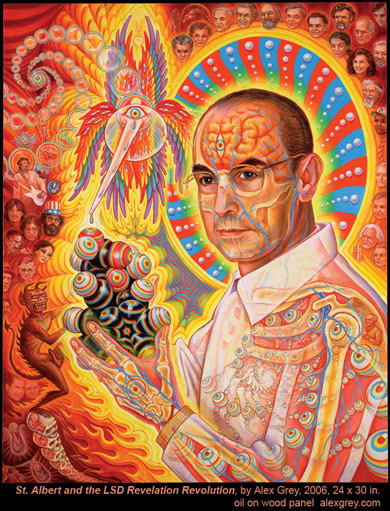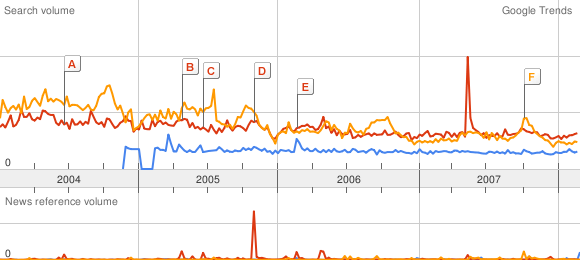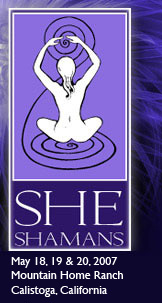Tag: awareness expansion
LSD wrap-up after Hofmann de-animates by John Walsh and bad brains and bad trops
by John Walsh
"Bicycle Day", 19 April, was later commemorated by acid enthusiasts because it was the first conscious "trip" and it had had – just about – a happy ending. But the doors to perception are, for some truth-seekers, booby-trapped and dangerous. When LSD was co-opted by medical staff for recreational use, two decades after Hoffman's bike ride, users learnt the hard way how impossible it was to control the wild ride once it had started.
At Oxford in the early 1970s, we were frankly intimidated by the drug's reputation. We all wanted to try it, but were too chicken. The word in the quad was: if you had any secret hang-ups, mental instabilities, phobias, sexual inadequacies or social insecurities (the kind that surface in dreams,) you were wise of steer clear of acid. We knew when one of us was going to try it. "Tonight," I'd hear during dinner in hall, "Roger's tripping for the first time. But he'll have Will and Ollie with him, so he'll be OK."
I've always remembered Roger's first trip (so, I'll bet, has he). We all knew he'd be fine because he was so perfect: cool, handsome, easy-going, a hit with the girls, a dead ringer, with his corkscrewy curls, for Marc Bolan of T. Rex. And he was rich; he owned a Morgan, which he casually parked in the back quad. We knew Roger would survive the experience and bang on about it, like he banged on about his Bang and Olufsen state-of-the-art hi-fi.http://tinyurl.com/4kc8fl 
Xenolinguist reports from Basel on mind-manifesting developments
okIt was massive. It was beautifully organized. The shift to a psychedelically informed culture is well underway. 1900-plus people, from 37 countries attended the four day event, according to Dieter Hagenbach, of gaiamedia, organizers of the event. A big bookstore. A room dedicated to video presentations–art and documentary.http://mazerunner.wordpress.com/
Alien Downloads
Altered states of consciousness are portals to multiple worlds. Many of these worlds are populated by sentient entities: gods; demons; plant teachers and animal spirits; Terence McKenna's machine elves. What forms of language are being used to communicate in these "Antipodes of the Mind?" Is language itself evolving in the psychedelic sphere? The Sundance Kid kept asking, "Who are those guys anyway?" The Xenolinguist wants to know what 'they' are trying to tell us. 
Daniel Kahneman – A Bat and a Ball Cost $1.10
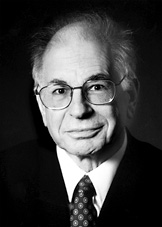 RIP Danny. Thank you for your insights and stories. I'm glad of the opportunity to know your work. You made a difference.
RIP Danny. Thank you for your insights and stories. I'm glad of the opportunity to know your work. You made a difference.
[Update 9/8/2010 A paper Danny co-authored, "Income's Influence on Happiness" has just been released.]
… the bat costs $1 more than the ball. How much does the ball cost? Daniel Kahneman KNOWS that the first thought that entered your head was $.10–even if you're a Computer Science major at MIT. But that's the wrong answer.
Daniel Gilbert's "Stumbling On Happiness" led me to Nicholas Taleb's "Fooled By Randomness". Both books cite the work of Danny Kahneman. I blogged a bit about him here. I have been rummaging around the internet looking for whatever I can find on Danny and his work and have come up with some excellent content. But let me give you a taste of the sort of fascinating facts you'll hear in Danny's lectures first.
In a study Danny (I don't know him personally but after listening to all these lectures, I feel as though I do. He could no doubt name the cognitive bias this suggests) mentions in one of his talks, people are asked how much pleasure they derive from their car. They are then asked enough questions about the car to determine its blue book (resale) value. It turns out that there IS a correlation between the amount of pleasure the subject reported and the dollar value of the car. i.e. Yes, that late model BMW in the garage DOES give you more pleasure than my 20 year old Honda would. BUT! They then go on to ask the subject if they find their commute to work pleasurable, and guess what?– nobody does!. It turns out that the ONLY time people derive pleasure from their car is when they are THINKING about it.
From Wikipedia:
With Amos Tversky (Kahneman's longtime research partner, with whom he would have shared the Nobel prize had Tversky not died in 1996) and others, Kahneman established a cognitive basis for common human errors using heuristics and biases (Kahneman & Tversky, 1973, Kahneman, Slovic & Tversky, 1982), and developed Prospect theory (Kahneman & Tversky, 1979). He was awarded the 2002 the Nobel Prize in Economics for his work in Prospect theory.
Major Contributions:
- anchoring and adjustment -describes the common human tendency to rely too heavily, or "anchor," on one trait or piece of information when making decisions.
- availability heuristic -where people base their prediction of the frequency of an event or the proportion within a population based on how easily an example can be brought to mind.
- conjunction fallacy -when it is assumed that specific conditions are more probable than a general condition that contains the specific condition. (i.e. You think you're MORE likely to die in an air disaster brought on by a terrorist event, than you are to die in ANY kind of air disaster).
- framing (economics) -reversals of preference when the same problem is presented in different ways. (10% fat vs. 90% fat-free!)
- loss aversion -the tendency for people strongly to prefer avoiding losses than acquiring gains. (Why New Yorkers stay in New York for the culture, and Angelenos stay in LA for the weather!!).
- peak-end rule – we judge our past experiences almost entirely on how they were at their peak (pleasant or unpleasant) and how they ended.
- prospect theory -how people make choices in situations where they have to decide between alternatives that involve risk.
- reference class forecasting -predicts the outcome of a planned action based on actual outcomes in a reference class of similar actions.
- simulation heuristic – people determine the likelihood of an event based on how easy it is to picture mentally. (Why we buy lottery tickets.)
- status quo bias -in other words, people like things to stay relatively the same.
Media – Most of these lectures have a fairly long-winded intro. Skip ahead if you don't need the background info.
Explorations of the Mind – Well-Being: Living and Thinking About It. (YouTube)
Conversation With History – Intuition and Rationality. (YouTube)
Conversation With History – Intuition and Rationality. (Audio)
Explorations of the Mind – Intuition: The Marvels and the Flaws. (YouTube)
Nobel Prize Lecture. (YouTube)
Update March 2009- Kahneman and Taleb on the same stage discus the crash. (YouTube)
Update March 2010. From the February 2010, Ted Talk Daniel Kahneman: The riddle of experience vs. memory. (YouTube)
Found a few more DK links.
A Perspective on Judgment and Choice 24pg. PDF doc. on the subject of his Nobel Prize.
The Allais Paradox Wired magazine 10/10 (Archive)
.
Albert Hofmann Transmitter/Receiver UCSB 1983
old Media on Hofmann's de-animation 1906-2008
this AM 30 Azid_Tao, 00,070 a.L. ( after LSDNATOM) . Saint Hofmann created LSD in Nov., 1938, so why not have this be the cusp of the change over of Epoch's? The most recent 10,000 year era ends and the New Epoch we are in starts with 00,001 for 1939? FERMI does the first nuclear pile in Dec. 1942. Hofmann discovers the effects of Azid_Tao in April , 1943….
and from the NYTimes this AM
Albert Hofmann, the Father of LSD, Dies at 102
PARIS – Albert Hofmann, the mystical Swiss chemist who gave the world LSD, the most powerful psychotropic substance known, died Tuesday at his hilltop home near Basel, Switzerland. He was 102.
The cause was a heart attack, said Rick Doblin, founder and president of the Multidisciplinary Association for Psychedelic Studies, a California-based group that in 2005 republished Dr. Hofmann's 1979 book "LSD: My Problem Child."
Dr. Hofmann first synthesized the compound lysergic acid diethylamide in 1938 but did not discover its psychopharmacological effects until five years later, when he accidentally ingested the substance that became known to the 1960s counterculture as acid.
He then took LSD hundreds of times, but regarded it as a powerful and potentially dangerous psychotropic drug that demanded respect. More important to him than the pleasures of the psychedelic experience was the drug's value as a revelatory aid for contemplating and understanding what he saw as humanity's oneness with nature. That perception, of union, which came to Dr. Hofmann as almost a religious epiphany while still a child, directed much of his personal and professional life.
Dr. Hofmann was born in Baden, a spa town in northern Switzerland, on Jan. 11, 1906, the eldest of four children. His father, who had no higher education, was a toolmaker in a local factory, and the family lived in a rented apartment. But Dr. Hofmann spent much of his childhood outdoors.
He would wander the hills above the town and play around the ruins of a Hapsburg castle, the Stein. "It was a real paradise up there," he said in an interview in 2006. "We had no money, but I had a wonderful childhood."
It was during one of his ambles that he had his epiphany.
"It happened on a May morning – I have forgotten the year – but I can still point to the exact spot where it occurred, on a forest path on Martinsberg above Baden," he wrote in "LSD: My Problem Child." "As I strolled through the freshly greened woods filled with bird song and lit up by the morning sun, all at once everything appeared in an uncommonly clear light.
"It shone with the most beautiful radiance, speaking to the heart, as though it wanted to encompass me in its majesty. I was filled with an indescribable sensation of joy, oneness and blissful security."
Though Dr. Hofmann's father was a Roman Catholic and his mother a Protestant, Dr. Hofmann, from an early age, felt that organized religion missed the point. When he was 7 or 8, he recalled, he spoke to a friend about whether Jesus was divine. "I said that I didn't believe, but that there must be a God because there is the world and someone made the world," he said. "I had this very deep connection with nature."
Dr. Hofmann went on to study chemistry at Zurich University because, he said, he wanted to explore the natural world at the level where energy and elements combine to create life. He earned his Ph.D. there in 1929, when he was just 23. He then took a job with Sandoz Laboratories in Basel, attracted by a program there that sought to synthesize pharmacological compounds from medicinally important plants.
It was during his work on the ergot fungus, which grows in rye kernels, that he stumbled on LSD, accidentally ingesting a trace of the compound one Friday afternoon in April 1943. Soon he experienced an altered state of consciousness similar to the one he had experienced as a child.
On the following Monday, he deliberately swallowed a dose of LSD and rode his bicycle home as the effects of the drug overwhelmed him. That day, April 19, later became memorialized by LSD enthusiasts as "bicycle day."
Dr. Hofmann's work produced other important drugs, including methergine, used to treat postpartum hemorrhaging, the leading cause of death from childbirth. But it was LSD that shaped both his career and his spiritual quest.
"Through my LSD experience and my new picture of reality, I became aware of the wonder of creation, the magnificence of nature and of the animal and plant kingdom," Dr. Hofmann told the psychiatrist Stanislav Grof during an interview in 1984. "I became very sensitive to what will happen to all this and all of us."
Dr. Hofmann became an impassioned advocate for the environment and argued that LSD, besides being a valuable tool for psychiatry, could be used to awaken a deeper awareness of mankind's place in nature and help curb society's ultimately self-destructive degradation of the natural world.
But he was also disturbed by the cavalier use of LSD as a drug for entertainment, arguing that it should be treated in the way that primitive societies treat psychoactive sacred plants, which are ingested with care and spiritual intent.
After his discovery of LSD's properties, Dr. Hofmann spent years researching sacred plants. With his friend R. Gordon Wasson, he participated in psychedelic rituals with Mazatec shamans in southern Mexico. He succeeded in synthesizing the active compounds in the Psilocybe mexicana mushroom, which he named psilocybin and psilocin. He also isolated the active compound in morning glory seeds, which the Mazatec also used as an intoxicant, and found that its chemical structure was close to that of LSD.
During the psychedelic era, Dr. Hofmann struck up friendships with such outsize personalities as Timothy Leary, Allen Ginsberg and Aldous Huxley, who, nearing death in 1963, asked his wife for an injection of LSD to help him through the final painful throes of throat cancer.
Yet despite his involvement with psychoactive compounds, Dr. Hofmann remained moored in his Swiss chemist identity. He stayed with Sandoz as head of the research department for natural medicines until his retirement in 1971. He wrote more than 100 scientific articles and was the author or co-author of a number of books
He and his wife, Anita, who died recently, reared four children in Basel. A son died of alcoholism at 53. Survivors include several grandchildren and great-grandchildren.
Though Dr. Hofmann called LSD "medicine for the soul," by 2006 his hallucinogenic days were long behind him, he said in the interview that year.
"I know LSD; I don't need to take it anymore," he said, adding. "Maybe when I die, like Aldous Huxley."
But he said LSD had not affected his understanding of death. In death, he said, "I go back to where I came from, to where I was before I was born, that's all."
http://www.nytimes.com/2008/04/30/world/europe/30hofmann.html?ref=world
Saint Albert Hofmann de-animates into very low resolution atoms/pixels
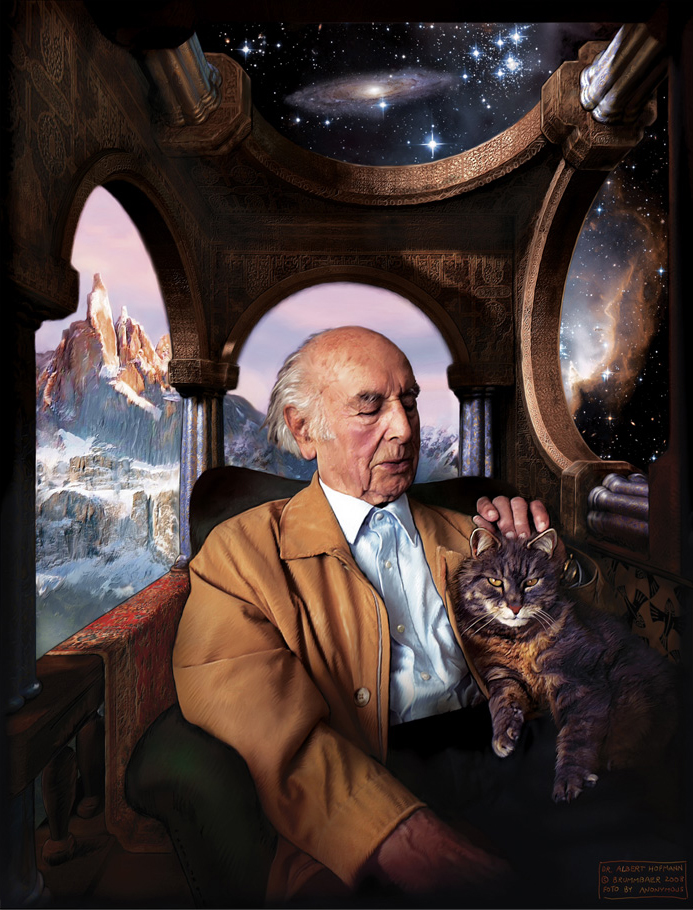
Prints of this portrait are available (sale benefits MAPS) here.
More about Artist Brummbaer
from MAPS.ORG site
Brummbaer recently completed his second book, What's So Wrong With Love and Peace: 1965-67. To find out more about Brummbaer's work visit his Web site: www.brummbaer.net
And now, here comes Brummbaer to show us how to use the screen for interpersonal communication;how to embrace, fondle, cuddle, snuggle, enliven our brain-exchanges to the level of the high spiritualart of India, China, Tibet, Rome, Egypt, Venice, Berlin. He has sculpted digital pixels into tender,caressing mind inter-play things.It is always the artists who blueprint and design the spirit of a culture. The 21st Century is beginning to express itself in the shimmering electronic realities of these digital wizards.
Timothy Leary Nov. 1990 Los Angeles
Michael Horowitz's Basel Talk!
Fri, 11 April 2008

This episode of psychonautica contains a talk by Michael Horowitz, from the recent World Psychedelic forum in Basel Switzerland. The title of the talk is 'The revolving doors of perception: deconstructing the myths and ambiguities of the psychedelic zeitgeist', Michael Horowitz talks about mythic events in Western history since the discovery of LSD 65 years ago.
http://dopecast.libsyn.com/index.php?post_id=327293
Quick download link see also MaxFreakOut link to talks http://www.thegrowreport.com/Forums/forumdisplay.php?f=39
Biblical Entheogens: a Speculative Hypothesis
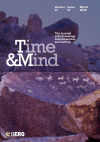 A lot of noise on the internet today around a recently published article in a new journal called Time and Mind by cognitive psychology professor Benny Shanon on the subject of Moses and Entheogens.
A lot of noise on the internet today around a recently published article in a new journal called Time and Mind by cognitive psychology professor Benny Shanon on the subject of Moses and Entheogens.
Abstract:
A speculative hypothesis is presented according to which the ancient Israelite religion was associated with the use of entheogens (mind-altering plants used in sacramental contexts). The hypothesis is based on a new look at texts of the Old Testament pertaining to the life of Moses. The ideas entertained here were primarily based on the fact that in the arid areas of the Sinai peninsula and Southern Israel there grow two plants containing the same psychoactive molecules found in the plants from which the powerful Amazonian hallucinogenic brew Ayahuasca is prepared. The two plants are species of Acacia tree and the bush Peganum harmala. The hypothesis is corroborated by comparative experiential-phenomenological observations, linguistic considerations, exegesis of old Jewish texts and other ancient Mideastern traditions, anthropological lore, and ethnobotanical data.
The entire 25 page article can be downloaded for free from here (scroll down to bottom of page, if the pdf link stops working let me know in the comments, I have a copy.)
| ayahuasca | peyote | magic mushrooms |
| Utah High Court OKs Non-Indian Peyote Use New York Newsday – Jun 23 2004 |
|
| American Indian church leader sues Utah officials over 2000 peyote raid KATC – Apr 28 2005 |
|
| 'Medicine man' arrested on peyote charges Centre Daily Times – Jun 24 2005 |
|
| Study: Religious peyote use not harmful to American Indians KESQ – Nov 4 2005 |
|
| Charges dropped vs. couple in peyote case Macon Telegraph – Feb 23 2006 |
|
| Netherlands bans magic mushrooms TREND Information – Oct 12 2007 |
See Also:
This is an article in two parts. The first part discusses current research in psychoactive preparations of ergot in various religious systems with a particular emphasis on Persian, Greek, Jewish and Islamic sources.
Incense is psychoactive: Scientists identify the biology behind the ceremony.
Six Degrees of Separation/Connection may be in trouble. Why can't 6/degrees find Osama bin laden?
Six Degrees has problems
ScienceFriday.com's version
Chances are you've heard of the 'small world' idea of six degrees of separation. But is it correct?
The idea traces back to an experiment begun in 1967 by Stanley Milgram, in which he tried to trace how many acquaintances it would take to pass a letter between two randomly selected people. The result that entered the public consciousness was that in general it took six steps or fewer to bridge the gap between any two people. But is that result accurate? Judith Kleinfeld,
http://www.sciencefriday.com/program/archives/200801256
tags, 6 degrees, Kevin Bacon Effect, six degrees, Milgram,
Seminars About Long Term Thinking
I've mentioned this before, but these lectures are just SO GOOD I think it worth repeating.
http://www.longnow.org/projects/seminars/
And check out what's coming up.
- 02007
- Dec. 14 (Friday) – Jon Ippolito & Joline Blais, "The Edge of Art"
- 02008
- Jan. 11 (Friday) – Paul Saffo, "Embracing Uncertainty: the secret to effective forecasting"
- Feb. 4 (MONDAY) – Nassim Nicholas Taleb, "The Future Has Always Been Crazier Than We Thought"
- Feb. 25 (MONDAY) – Craig Venter, "Joining 3.5 Billion Years of Microbial Invention"
- Apr. 25 (Friday) – Niall Ferguson & Peter Schwartz, "Historian vs. Futurist on Human Progress"
- May 21 (WEDNESDAY) – Iqbal Quadir, "Technology Empowers the Poorest"
- Jul. 23 (WEDNESDAY) – Edward Burtynsky, "The 10,000-year Gallery"
2007 Women's Visionary Congress Audio Recordings
2007 Women's Visionary Congress Audio Recordings
The Women's Visionary Congress is a gathering of healers, activists, researchers and artists who are redefining the use of entheogens in contemporary society. This Congress will address the traditional uses of these substances and investigations into their therapeutic applications. Read more…
Favorites:
Annie Sprinkle
Adele Getty
Kat Harrison
Carolyn "Mountain Girl" Garcia
Long Dark night by John Fogerty
jF
George is in the jungle
knockin' on the door
come to get your children
wants to have a war
Long Dark Night Lyrics
